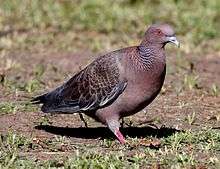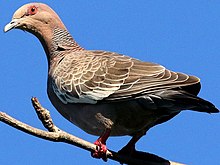Picazuro pigeon
The picazuro pigeon (Patagioenas picazuro) is a pigeon native to South America.
| Picazuro pigeon | |
|---|---|
 | |
| In Buenos Aires, Argentina | |
 | |
| In Rodrigo de Freitas Lagoon, Brazil | |
| Scientific classification | |
| Kingdom: | Animalia |
| Phylum: | Chordata |
| Class: | Aves |
| Order: | Columbiformes |
| Family: | Columbidae |
| Genus: | Patagioenas |
| Species: | P. picazuro |
| Binomial name | |
| Patagioenas picazuro Temminck, 1813 | |
 | |
| Estimated range of Patagioenas picazuro in blue. | |
It is a large pigeon with a wingspan of up to 22 inches and can weigh as much as 1 pound. [2]
Description
Patagioenas picazuro is a brown bird with white dashes on the back of its neck and darker brown wing patterns. It is similar in appearance to the spotted dove.
Distribution
The picazuro pigeon is found in Argentina, Bolivia, Brazil, Paraguay and Uruguay. It has an estimated global extent of occurrence of 5,800,000 km2 and although an accurate population count has not taken place, it is believed that the species is common and the population is thought to be increasing. Picazuro pigeons survive in a variety of habitats; from woodland and forest to agricultural land.
Diet
This species feeds mainly on the ground and like most other pigeons eats seeds and grain.
Reproduction
Picazuro pigeons nest in every month of the year. A fragile nest is built from sticks and one egg is laid. Both parents incubate the egg. Once the egg has hatched, the chick is fed on crop milk and then regurgitated seeds.
References
- BirdLife International (2012). "Patagioenas picazuro". IUCN Red List of Threatened Species. 2012. Retrieved 26 November 2013.CS1 maint: ref=harv (link)
- "Southern Outfitting: Argentina Pigeon". Retrieved 10 August 2020.
External links
- Picazuro pigeon in Ceará, Brazil: Photo, vocalization from www.birds-caatinga.com
- Citizen science observations for Picazuro pigeon at iNaturalist
| Wikimedia Commons has media related to Patagioenas picazuro. |
